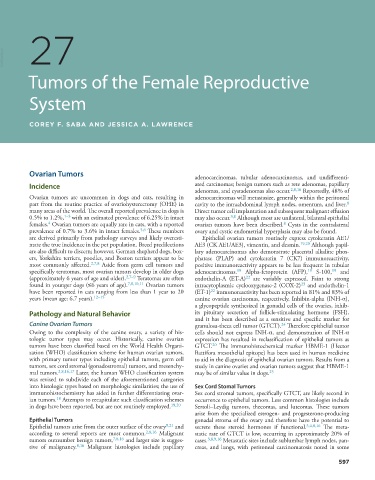Page 619 - Withrow and MacEwen's Small Animal Clinical Oncology, 6th Edition
P. 619
27
VetBooks.ir
Tumors of the Female Reproductive
System
COREY F. SABA AND JESSICA A. LAWRENCE
Ovarian Tumors adenocarcinomas, tubular adenocarcinomas, and undifferenti-
Incidence ated carcinomas; benign tumors such as rete adenomas, papillary
adenomas, and cystadenomas also occur. 2,8,16 Reportedly, 48% of
Ovarian tumors are uncommon in dogs and cats, resulting in adenocarcinomas will metastasize, generally within the peritoneal
8
part from the routine practice of ovariohysterectomy (OHE) in cavity to the intraabdominal lymph nodes, omentum, and liver.
many areas of the world. The overall reported prevalence in dogs is Direct tumor cell implantation and subsequent malignant effusion
3,8
0.5% to 1.2%, 1–3 with an estimated prevalence of 6.25% in intact may also occur. Although most are unilateral, bilateral epithelial
4
8
females. Ovarian tumors are equally rare in cats, with a reported ovarian tumors have been described. Cysts in the contralateral
5,6
prevalence of 0.7% to 3.6% in intact females. These numbers ovary and cystic endometrial hyperplasia may also be found.
are derived primarily from pathology surveys and likely overesti- Epithelial ovarian tumors routinely express cytokeratin AE1/
mate the true incidence in the pet population. Breed predilections AE3 (CK AE1/AE3), vimentin, and desmin. 19,20 Although papil-
are also difficult to discern; however, German shepherd dogs, box- lary adenocarcinomas also demonstrate placental alkaline phos-
ers, Yorkshire terriers, poodles, and Boston terriers appear to be phatase (PLAP) and cytokeratin 7 (CK7) immunoreactivity,
most commonly affected. 2,7,8 Aside from germ cell tumors and positive immunoreactivity appears to be less frequent in tubular
19
19
19
specifically teratomas, most ovarian tumors develop in older dogs adenocarcinomas. Alpha-fetoprotein (AFP), S-100, and
(approximately 6 years of age and older). 2,7–9 Teratomas are often endothelin-A (ET-A) are variably expressed. Faint to strong
22
23
found in younger dogs (≤6 years of age). 7,8,10,11 Ovarian tumors intracytoplasmic cyclooxygenase-2 (COX-2) and endothelin-1
22
have been reported in cats ranging from less than 1 year to 20 (ET-1) immunoreactivity has been reported in 81% and 83% of
years (mean age: 6.7 years). 12–15 canine ovarian carcinomas, respectively. Inhibin-alpha (INH-α),
a glycopeptide synthesized in gonadal cells of the ovaries, inhib-
Pathology and Natural Behavior its pituitary secretion of follicle-stimulating hormone (FSH),
and it has been described as a sensitive and specific marker for
Canine Ovarian Tumors granulosa-theca cell tumor (GTCT). Therefore epithelial tumor
24
Owing to the complexity of the canine ovary, a variety of his- cells should not express INH-α, and demonstration of INH-α
tologic tumor types may occur. Historically, canine ovarian expression has resulted in reclassification of epithelial tumors as
tumors have been classified based on the World Health Organi- GTCT. The immunohistochemical marker HBME-1 (Hector
20
zation (WHO) classification scheme for human ovarian tumors, Battifora mesothelial epitope) has been used in human medicine
with primary tumor types including epithelial tumors, germ cell to aid in the diagnosis of epithelial ovarian tumors. Results from a
tumors, sex cord stromal (gonadostromal) tumors, and mesenchy- study in canine ovaries and ovarian tumors suggest that HBME-1
mal tumors. 2,8,16,17 Later, the human WHO classification system may be of similar value in dogs.
25
was revised to subdivide each of the aforementioned categories
into histologic types based on morphologic similarities; the use of Sex Cord Stomal Tumors
immunohistochemistry has aided in further differentiating ovar- Sex cord stromal tumors, specifically GTCT, are likely second in
18
ian tumors. Attempts to recapitulate such classification schemes occurrence to epithelial tumors. Less common histologies include
in dogs have been reported, but are not routinely employed. 19,20 Sertoli–Leydig tumors, thecomas, and luteomas. These tumors
arise from the specialized estrogen- and progesterone-producing
Epithelial Tumors gonadal stroma of the ovary and therefore have the potential to
Epithelial tumors arise from the outer surface of the ovary 9,21 and secrete these steroid hormones if functional. 3,4,8,16 The meta-
according to several reports are most common. 2,8,16 Malignant static rate of GTCT is low, occurring in approximately 20% of
tumors outnumber benign tumors, 7,8,16 and larger size is sugges- cases. 3,8,9,16 Metastatic sites include sublumbar lymph nodes, pan-
tive of malignancy. 8,16 Malignant histologies include papillary creas, and lungs, with peritoneal carcinomatosis noted in some
597

